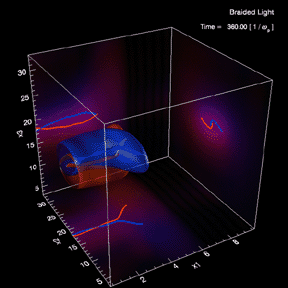|
|
|
|
Mutual Interaction of Photon Beams in a Plasma: Braided Lights Light beams do not interact in vacuum. However, in a plasma there is a self-interaction as is obvious from the well known self-focusing mechanisms. This naturally leads to the question, is there a mutual interaction between two (or more) light beams in a nonlinear optical medium, such as a plasma? We show using a variational principle method, that the relativistic mass nonlinearity causes an effective attractive force between two Gaussian laser beams in a plasma. The centroid of each laser moves just like a point mass (with the laser power playing the role of mass) under this exponential attractive force, This force will cause two Gaussian beams to spiral around each other if the beams enter the plasma with some angular momentum about their effective center of mass. Furthermore, if they enter the plasma with no angular momentum they periodically pass through each other. Both the rotation period and the oscillation period are proportional to the Rayleigh length. The spiral orbits are stable if the ratio of orbit diameter to laser spot size (d/W)2<2. Three dimensional particle-in-cell simulations using OSIRIS have confirmed these analytical solutions. The simulations show that the actual solutions lead to the light beams braiding around each other. While we have concentrated on the relativistic mass nonlinearity the conclusions should apply to any nonlinearity and the results also have direct relevance to the interaction of individual filaments and speckles. This work is published in Physical Review Letters. |
The iso-surfaces and calculated centroids of the electric field of the two lasers. The lines on the box walls are projections of the centroids. The braiding of the lasers can be clearly seen. click on image for larger view |
| A movie of the iso-surfaces and calculated centroids of the electric field of the two lasers showing the spiraling of the lasers. The lasers appear to move out of the back of the simulation window because the window is moving at the vacuum speed of light, faster than the light speed in the plasma. |
click on icon to open movie |



